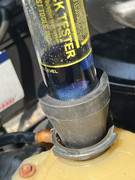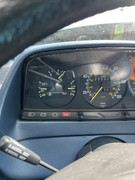I continued down my engine temperature rabbit hole today.
First I tested the temp sender with my electric kettle. I set the kettle to 85*C and suspended the sender in the water such that I could access the pin on top with my DMM. I checked the resistance at 85*C and it was around 54ohms. This was within the VDO chart tolerance, so this sender checks out.
Then I borrowed a block tester from a buddy to see if I could see combustion gasses in the coolant. I took the car from a spin, and got the temp gauge up to the usual 95-98*C. While idling I used the block tester bulb to suck up air from the expansion tank. No color change of the fluid was observed. I then used the radiator top tube to 'squish' more water into the expansion tank and force air thru the tester. Again, no color change was observed. While this is probably not a conclusive test, I feel that I would have seen the fluid change color if there was enough of a leak to bubble coolant out of the head.

With the car still at idle, air conditioning on max, and temp gauge reading around 98C, I measured the resistance at the sender to be 55.7ohms. This tells me that the car is actually running between 84*C and 90*C based on the tolerance of the sender. I feel this generally aligns with my thermocouple measurements, since a loss of a few *C through the body of the sender is expected.


I believe this confirms that my gauge is reading about 10*C too high. Also, while plugging and unplugging the temp sender connector, the gauge sometimes read as high as 110*C. I would then re-plug the connector and the temp would return to around 100*C. Next steps will be pulling the cluster to investigate grounds and burnt traces.









